The Dell Venue 11 Pro 7000 Review
by Brett Howse on April 16, 2015 8:00 AM EST- Posted in
- Tablets
- Dell
- Windows 8.1
- Core M
Display
Much like a smartphone, the display of a tablet is one of the most critical elements. Not only is it the only method of receiving information, it is also the primary method at input. A mediocre tablet can get by with a poor display, but unlike laptops the bar for poor displays on a tablet is much higher. A good tablet needs a good display, and Dell has delivered here.
The Venue 11 Pro is equipped with a Samsung SDC4C48 panel, which is an 8 bit model. The 10.8 inch panel is 1920x1080, for a good 204 pixels per inch. While not class leading in pixel density, everything looks clear and sharp. It is also a good compromise for desktop use, where you can pretty easily get by with just 125% scaling to keep a reasonable amount of desktop real estate available.
Dell Venue 11 Pro Pixel Arrangement
The Samsung display is a full RGB stripe, so there is no question about subpixel density like on a RGBW pentile arrangement. Color accuracy is generally better as well with RGB, and to test that, we will turn to SpectralCal’s CalMAN 5 suite, along with an X-Rite i1Display Pro colorimeter for brightness and contrast measurements, and the X-Rite i1Pro spectrophotometer for color accuracy testing.
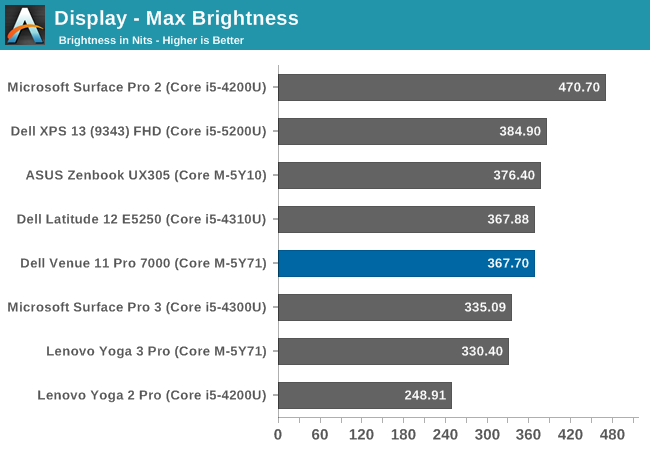
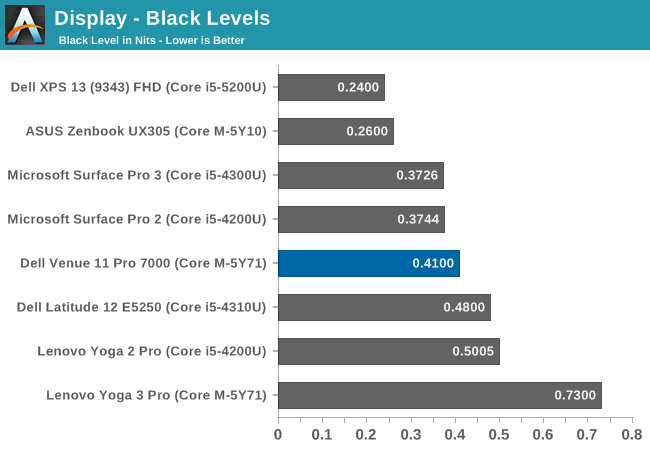
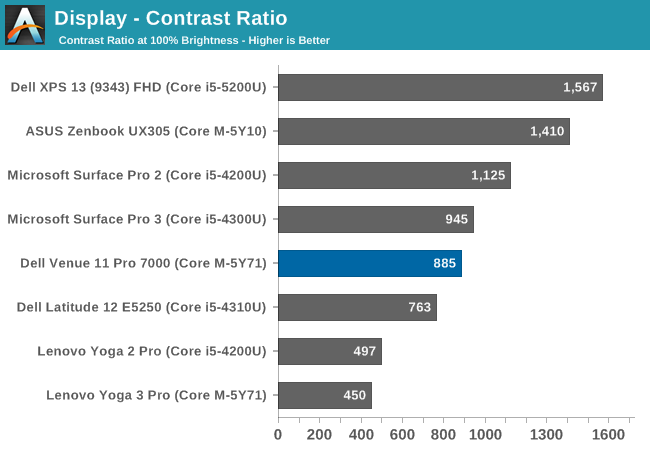
Dell’s premium Windows tablet starts off quite well, with good brightness at about 370 nits. The black levels are just OK though, which results in a good but not spectacular 885:1 contrast ratio. For those that need a dim display for use in a darker environment, The Venue 11 Pro goes down to around 18 nits so it should be no problem there.

Looking at grayscale, the Venue 11 Pro has not too bad of a score out of the box, but it could use some work. Overall the dE2000 is 4.38, which is due to the greens being a bit too strong, and the gamma falls off of the 2.2 target especially at the upper brightness levels. The white point is good overall though at 6615, very close to the ideal target of 6504.
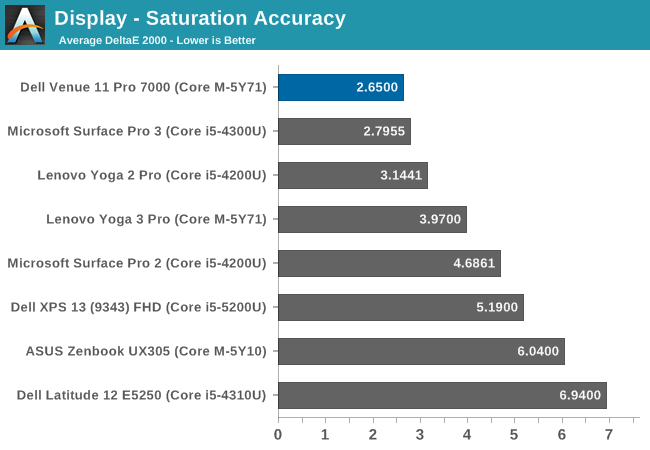
The saturation sweep is excellent, with an overall dE2000 of just 2.65, nicely under the target score of 3.0. The reds are a bit compressed though, and the 100% red is closer to 80% than 100%. The other colors are very close to their targets though.
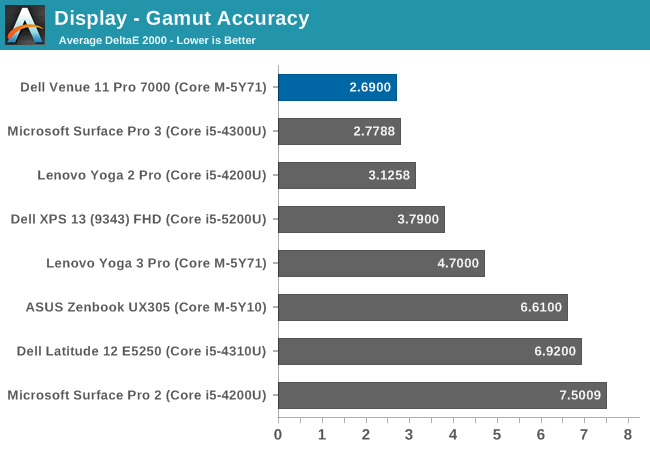
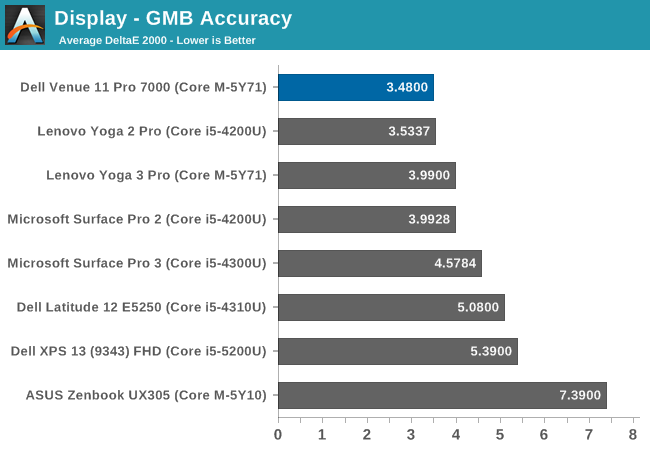
The Gretag MacBeth colorchecker is the most comprehensive test, and the overall score is 3.48, which is just above the 3.0 target. For an out of the box experience, few would complain about the Dell Venue 11 Pro tablet. Colors are generally quite good, and the brightness and contrast is also good.
Being a Windows tablet, we can also calibrate the display. Since the worst offender was the grayscale performance, calibration should help a lot to pull those scores down.
Once calibrated, this display is almost perfect. The grayscale falls to 0.71, and the gamma is almost spot on. Gamut falls to just 1.41, saturations are 0.83, and the GMB score drops to 1.13. Out of the box, the display is already good, but once calibrated it is fantastic.
Few would be left wanting with the Venue 11’s display. It has the kind of quality display one would expect in a premium tablet. Color accuracy is good out of the box, but because it is Windows it can be improved upon assuming one has the tools to do so. Really the only issue I had with the display is the 16:9 ratio, which works great for media consumption like MLB.TV and the like, but a taller overall display would make it a better tablet for both portrait and landscape modes.


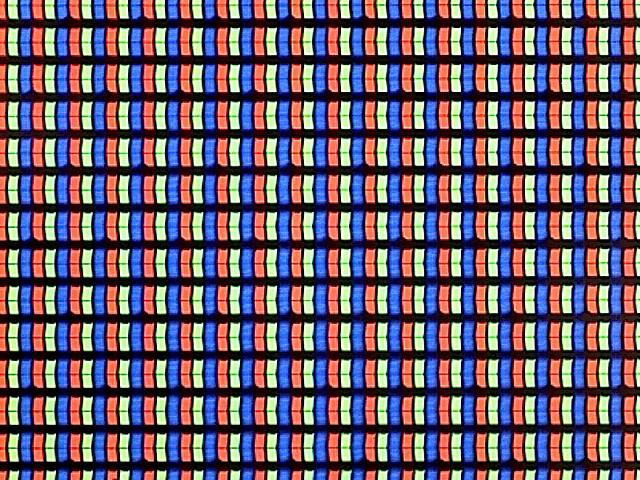
















92 Comments
View All Comments
gijames1225 - Thursday, April 16, 2015 - link
Out of curiosity, why aren't MacBook Air battery life times available in the comparison chart? Those are normally held up to be the standard for battery life.Brett Howse - Thursday, April 16, 2015 - link
They are no longer the standard, Dell has passed the Air with the XPS 13. But you can see everything in Bench http://www.anandtech.com/bench/Notebook/620TEAMSWITCHER - Thursday, April 16, 2015 - link
That depends on who you want to believe. CNet did some battery benchmark tests of the XPS 13 and found that it got only 5 hours compared to 8.5 hours on the MacBook Air. Having used a MacBook Air heavily and actually gotten over 8 hours of use from it, I tend to believe CNet. I never feel the need to carry my charger with me, but I have a coworker with an XPS 13 who never seems to be without it. That's also quite telling, IMHO.TEAMSWITCHER - Thursday, April 16, 2015 - link
Correction... The Battery Numbers for the XPS came from Gizmodo....not CNet.YuLeven - Thursday, April 16, 2015 - link
Remember that the MacBook Air has a crappy low resolution TN display that accounts for a reduced energy usage.TEAMSWITCHER - Thursday, April 16, 2015 - link
I'm using that display right now....and it looks shaper than the 27 inch IPS 2560x1440 display on the iMac directly behind it. TN displays aren't all bad...the ones used in the MacBook Air are good quality. And the pixel density is still higher than just about every desktop monitor that's not 4K or better.My biggest complaint about the screen is the size...11" is a bit too small. But the 13" MacBook Air felt a bit too big....too much like a traditional notebook. For me, this 11" MacBook Air is like my iPad...I take it with me everywhere.....except that I can do real work on it.
YuLeven - Friday, April 17, 2015 - link
Fine, in your experience it outscores the perceived sharpness of ordinary desktops. But wasn't the QHD+ screen equipped XPS 13 the whole point of the comparison? Heck, even the rMBP 13 (which I absolutely love) makes the MBA kind of a dubious choice. The point is: The Air makes compromises to delivery it's extra battery life - one being below average screen for it's price point.akdj - Saturday, April 18, 2015 - link
But the 'only' one in the lineup to not be given the hiDPI 'treatment' ala "Retina". Will the 12" replace it? Or will the Air continue to be an entry level laptop? Time will tell, but one thing's for sure, regardless of the XPS battery life, one still has to deal with Win's awful scaling algorithms (or lack there of). The trade off isn't worth it (especially touch as hiDPI displays targets are tiny and mandate using a stylus, not finger). The TN panels on the Airs while not IPS are of the highest quality and 'look' better than most OEM displays out of the box due to simple calibration pre-sale. The 'only' compromise is your opinion of a 'below average screen' which can be eliminate for a couple hundred bucks and an external display of choice. The iGPU in the Air is excellent and the processor choices, PCIe storage speeds and phenomenal 'support' are beyond any other OEM's abilities right now. In fact, Apple is replacing the logic board on one of our '11 MBAs out of warranty. Gratis. It's JUST the kind of thing that makes OS X and Apple such an excellent choice, not to mention it's still my favorite machine to run Windows on ;)id4andrei - Thursday, April 16, 2015 - link
CNet is not the standard, Anandtech is. Anandtech has the thorough and transparent testing suite and uses native browsers for all platforms. Cnet is like all the other tech bloggers that are in Apple's camp. They test PCs with itunes for video playback and Chrome for browsing while giving macs the benefit of native Safari. They also don't adjust for panel brightness.akdj - Saturday, April 18, 2015 - link
I agree, and love reading reviews her, ARS and Display Mate. But there are often discrepancies and one must decide on their own which review to go by. 'Apple's camp'. Seriously? Good. Lord